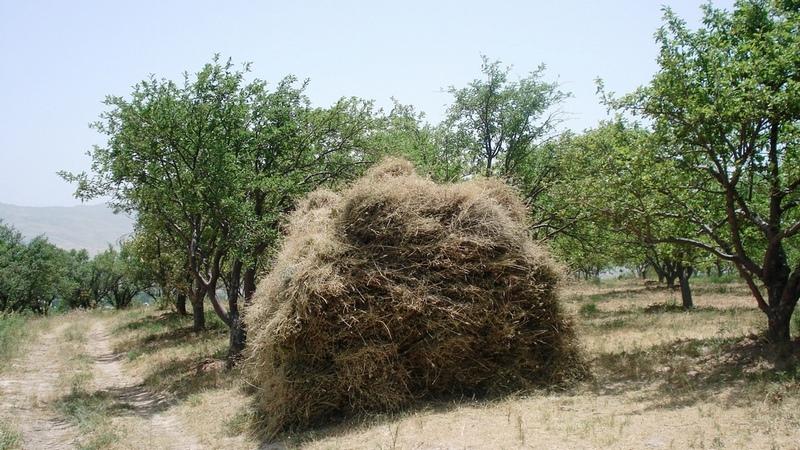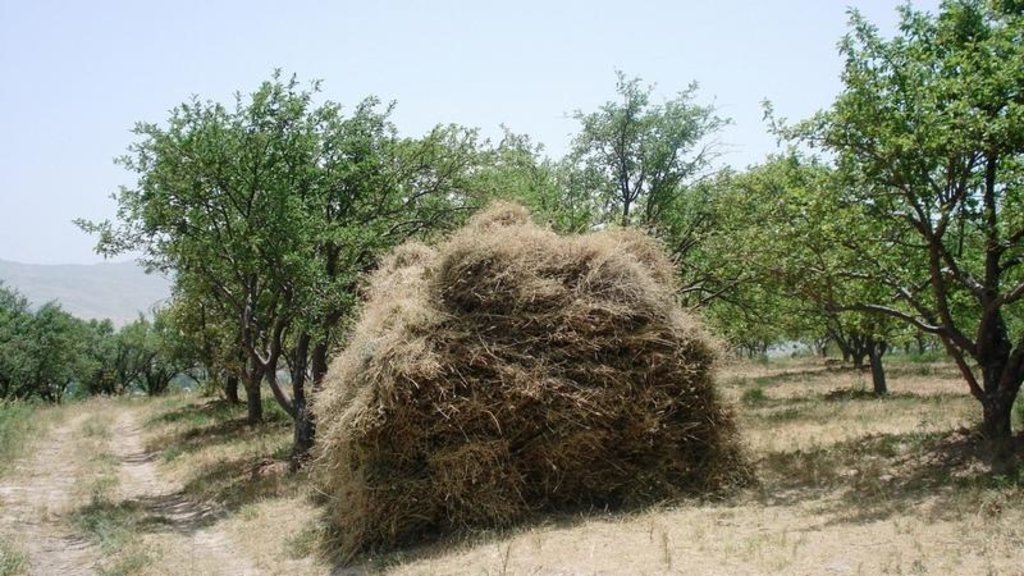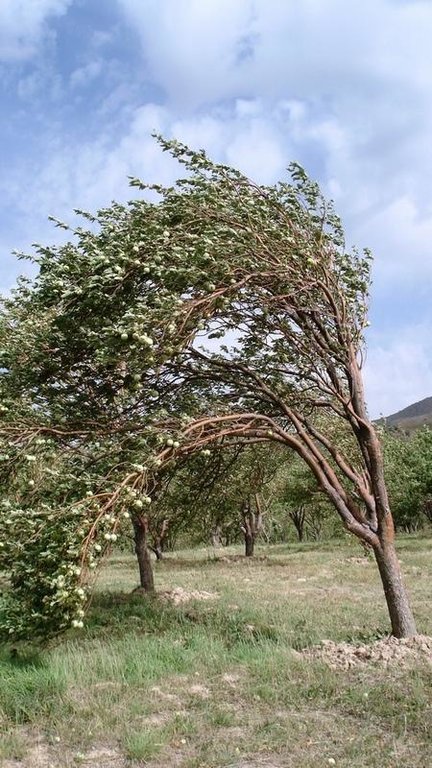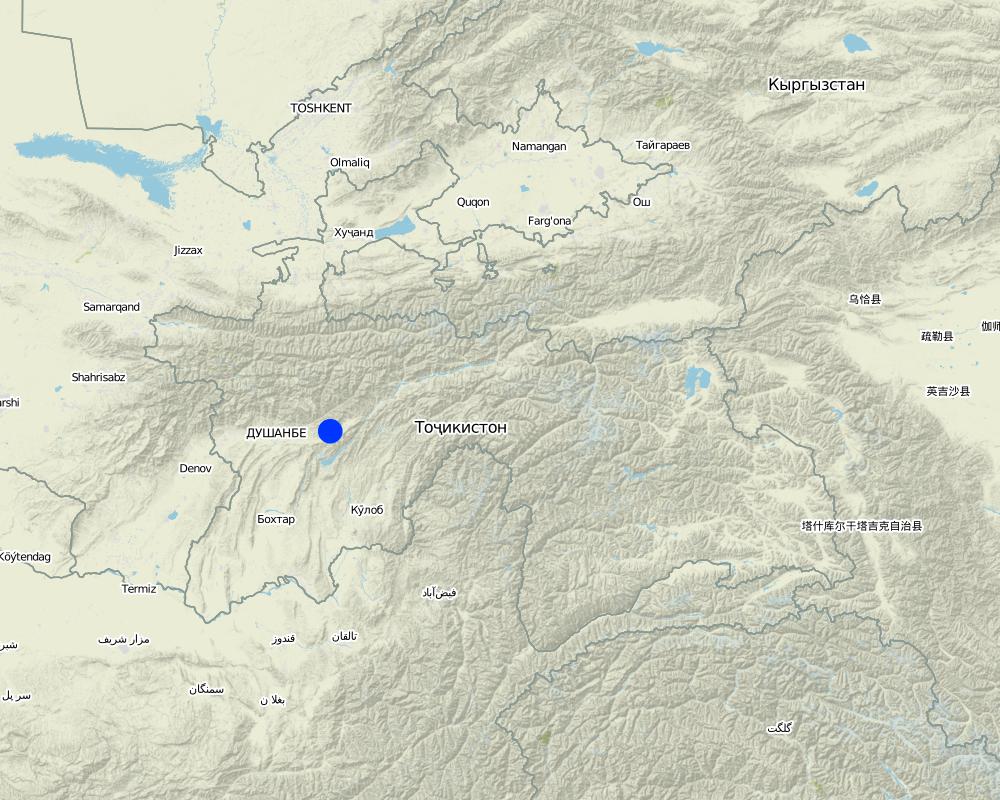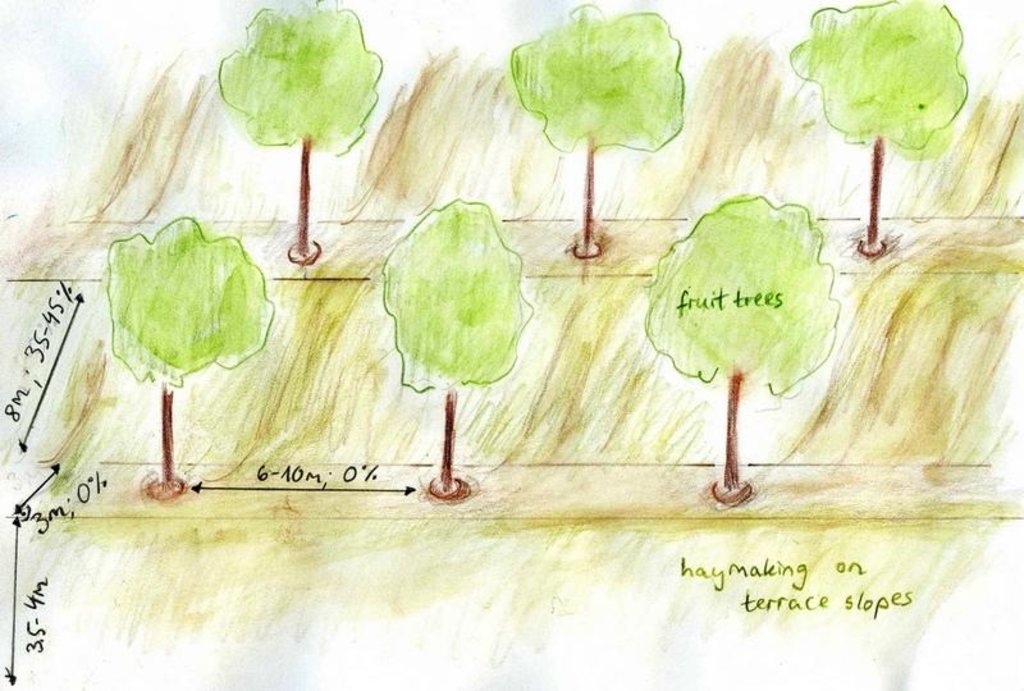Combined cut-and-carry and fruit-production system with terraces [ทาจิกิสถาน]
- ผู้สร้างสรรค์:
- การอัพเดท:
- ผู้รวบรวม: Christian Wirz
- ผู้เรียบเรียง: –
- ผู้ตรวจสอบ: David Streiff, Alexandra Gavilano
Зина бох (tajik for terrace garden)
technologies_1406 - ทาจิกิสถาน
ดูส่วนย่อย
ขยายทั้งหมด ย่อทั้งหมด1. ข้อมูลทั่วไป
1.2 รายละเอียดที่ติดต่อได้ของผู้รวบรวมและองค์กรที่เกี่ยวข้องในการประเมินและการจัดเตรียมทำเอกสารของเทคโนโลยี
ชื่อขององค์กรซึ่งอำนวยความสะดวกในการทำเอกสารหรือการประเมินเทคโนโลยี (ถ้าเกี่ยวข้อง)
CDE Centre for Development and Environment (CDE Centre for Development and Environment) - สวิตเซอร์แลนด์ชื่อขององค์กรซึ่งอำนวยความสะดวกในการทำเอกสารหรือการประเมินเทคโนโลยี (ถ้าเกี่ยวข้อง)
NCCR North-South (NCCR North-South) - คีร์กีซสถาน1.3 เงื่อนไขการใช้ข้อมูลที่ได้บันทึกผ่านทาง WOCAT
ผู้รวบรวมและวิทยากรหลักยอมรับเงื่อนไขเกี่ยวกับการใช้ข้อมูลที่ถูกบันทึกผ่านทาง WOCAT:
ใช่
1.5 Reference to Questionnaire(s) on SLM Approaches (documented using WOCAT)
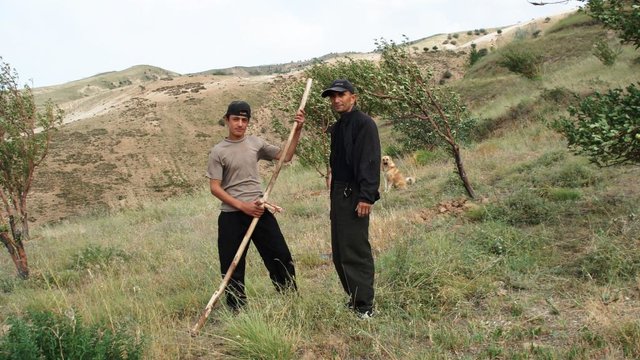
State-controlled research territory for orcharding [ทาจิกิสถาน]
Cultivation of an orchard with research activities and research staff with food for work.
- ผู้รวบรวม: Christian Wirz
2. การอธิบายลักษณะของเทคโนโลยี SLM
2.1 การอธิบายแบบสั้น ๆ ของเทคโนโลยี
คำจำกัดความของเทคโนโลยี:
A combination of fruit- and nut-trees together with seminatural trees and shrubs on one side with grass-communities on the other side provide for a diversified production system.
2.2 การอธิบายแบบละเอียดของเทคโนโลยี
คำอธิบาย:
Fruit- and nut-trees give the production system the characteristics of an orchard, whereas sour cherry trees rather provide for a jungle atmosphere. They spread very quickly once they are planted. Hayproduction substitutes other uses of the lowest vegetation layer, since grazing is forbidden. The whole territory is concipied as a research station.
Purpose of the Technology: In general trees act against erosion: By their stabilising function they prevent soil from being washed out. Especially nut-trees with their 20 to 25 m long roots preserve soil moisture and by that consolidate soil structure. Terraces contribute to this moisture-preserving and production-enhancing function. They are very important in order to make rather steep land exploitable by reducing slope. Haymaking does not damage soils, but is only allowed after the end of June so that grasses can reproduce before.
Establishment / maintenance activities and inputs: Both the establishment of terraces and the planting of trees on such a big surface are costly in terms of labour and money. Maintenance means taking care of trees, taking measures against diseases and conserving soil fertility. Fertilisers are very costly and therefore dung has been substituting them in the last years.
Natural / human environment: From the two research stations of the orchard institute - one in the upper hill-zone and one close to the village Karsang - only the second one is assessed. This area is surrounded by two rivers in the West and in the East, with its main exposition to the South. It is in direct competition for irrigation water, especially needed for the trees, with the village. The orchard is situated on a ridge that is in the haymaking area, but is accessible for animals from the village.
2.3 รูปภาพของเทคโนโลยี
2.5 ประเทศภูมิภาค หรือสถานที่ตั้งที่เทคโนโลยีได้นำไปใช้และได้รับการครอบคลุมโดยการประเมินนี้
ประเทศ:
ทาจิกิสถาน
ภูมิภาค/รัฐ/จังหวัด:
Region of Republican Subordination
ข้อมูลจำเพาะเพิ่มเติมของสถานที่ตั้ง :
Faizabad
ระบุการกระจายตัวของเทคโนโลยี:
- กระจายไปอย่างสม่ำเสมอในพื้นที่
If precise area is not known, indicate approximate area covered:
- 0.1-1 ตร.กม.
แสดงความคิดเห็น:
Total area covered by the SLM Technology is 0.7 km2.
Of the 70 hectares nearly half of the surface can be considered as unproductive with protective functions against erosion (many sour cherry trees planted).
Map
×2.6 วันที่การดำเนินการ
ถ้าไม่รู้ปีที่แน่นอน ให้ระบุวันที่โดยประมาณ:
- 10-50 ปี
2.7 คำแนะนำของเทคโนโลยี
ให้ระบุว่าเทคโนโลยีถูกแนะนำเข้ามาอย่างไร:
- ด้วยการริเริ่มของผู้ใช้ที่ดินเอง
- ทางโครงการหรือจากภายนอก
ความคิดเห็น (ประเภทของโครงการ เป็นต้น) :
1961 the national orchard institute began with developing a research area in Karsang, which should be further enlarged from 1975 onward.
3. การจัดประเภทของเทคโนโลยี SLM
3.1 วัตถุประสงค์หลักของเทคโนโลยี
- ลด ป้องกัน ฟื้นฟู การเสื่อมโทรมของที่ดิน
3.2 ประเภทของการใช้ที่ดินในปัจจุบันที่ได้นำเทคโนโลยีไปใช้

พื้นที่ปลูกพืช
- การปลูกไม้ยืนต้น ไม้พุ่ม
Tree and shrub cropping - Specify crops:
- fruits, other
- stone fruits (peach, apricot, cherry, plum, etc)
- tree nuts (brazil nuts, pistachio, walnuts, almonds, etc.)
จำนวนของฤดูเพาะปลูกต่อปี:
- 1
ระบุ:
Longest growing period in days: 270 Longest growing period from month to month: Oct - Jul

ทุ่งหญ้าเลี้ยงสัตว์
ทุ่งหญ้าเลี้ยงสัตว์ที่มีการจัดการแบบเข้มข้นหรือการผลิตอาหารสัตว์:
- ตัดแล้วขนไป / ไม่มีการปล่อยแทะเล็มเอง (Cut-and-carry / zero grazing)
- Access for livestock forbidden.
แสดงความคิดเห็น:
Livestock density (if relevant):
< 1 LU/km2
Major land use problems (compiler’s opinion): The main problems are arid conditions and the loss of fertility, mainly by processes of water erosion.
Major land use problems (land users’ perception): Gully erosion by water and wind erosion together with droughts are the main problems. Gullly erosion may also be caused by
Cut-and-carry/ zero grazing: Access for livestock forbidden.
Grazingland comments: People have goats, sheep and cows and 1-2 donkeys, if they can afford.
Type of grazing system comments: People have goats, sheep and cows and 1-2 donkeys, if they can afford.
3.4 การใช้น้ำ
การใช้น้ำของที่ดินที่มีการใช้เทคโนโลยีอยู่:
- จากน้ำฝน
แสดงความคิดเห็น:
Water supply: post-flooding
3.5 กลุ่ม SLM ที่ตรงกับเทคโนโลยีนี้
- การปรับปรุงดิน / พืชคลุมดิน
- การปรับปรุงพันธุ์พืชหรือพันธุ์สัตว์ต่าง ๆ
3.6 มาตรการ SLM ที่ประกอบกันเป็นเทคโนโลยี

มาตรการอนุรักษ์ด้วยวิธีพืช
- V1: ต้นไม้และพุ่มไม้คลุมดิน

มาตรการอนุรักษ์ด้วยโครงสร้าง
- S1: คันดิน

มาตรการอนุรักษ์ด้วยการจัดการ
- M2: การเปลี่ยนแปลงของการจัดการหรือระดับความเข้มข้น
แสดงความคิดเห็น:
Main measures: vegetative measures, management measures
Secondary measures: structural measures
Type of vegetative measures: aligned: -linear
3.7 รูปแบบหลักของการเสื่อมโทรมของที่ดินที่ได้รับการแก้ไขโดยเทคโนโลยี

การกัดกร่อนของดินโดยน้ำ
- Wt (Loss of topsoil): การสูญเสียดินชั้นบนหรือการกัดกร่อนที่ผิวดิน
- Wg (Gully erosion): การกัดกร่อนแบบร่องธารหรือการทำให้เกิดร่องน้ำเซาะ

การกัดกร่อนของดินโดยลม
- Et (Loss of topsoil): การสูญเสียดินชั้นบน

การเสื่อมโทรมของดินทางด้านเคมี
- Cn (Fertility decline): ความอุดมสมบูรณ์และปริมาณอินทรียวัตถุในดินถูกทำให้ลดลงไป (ไม่ได้เกิดจากสาเหตุการกัดกร่อน)

การเสื่อมโทรมของดินทางด้านกายภาพ
- Pc (Compaction): การอัดแน่น
- Pk (Slaking and crusting): การอุดตันของช่องว่างในดินหรือรูพรุน
- Pi (Soil sealing)

การเสื่อมโทรมของดินทางด้านชีวภาพ
- Bc (Reduction of vegetation cover): การลดลงของจำนวนพืชที่ปกคลุมดิน
แสดงความคิดเห็น:
Main type of degradation addressed: Wt: loss of topsoil / surface erosion, Et: loss of topsoil
Secondary types of degradation addressed: Wg: gully erosion / gullying, Cn: fertility decline and reduced organic matter content, Pc: compaction, Pk: sealing and crusting, Bc: reduction of vegetation cover
Main causes of degradation: change of seasonal rainfall (According to agronomist and elderly persons steady decrease of rainfall Causing aridification..), droughts (No considerable precipitation for one and a half years. Causing compaction, crusting and aridification.), inputs and infrastructure: (roads, markets, distribution of water points, other, …) (The lack of fertilisers and other inputs is a consequence of the breakdown of URSS.)
Secondary causes of degradation: floods (Causing gully erosion and loss of topsoil by water.), war and conflicts (Many trees were chopped illegally during war to have energy (charcoal mines were occupied by armed men)), Unsuitable soils especially in the upper part (loe (Causing compaction, crusting and loss of topsoil by wind.), Steep topography with high sun inclination angle (Causing compaction.)
3.8 การป้องกัน การลดลง หรือการฟื้นฟูความเสื่อมโทรมของที่ดิน
ระบุเป้าหมายของเทคโนโลยีกับความเสื่อมโทรมของที่ดิน:
- ป้องกันความเสื่อมโทรมของที่ดิน
- ลดความเสื่อมโทรมของดิน
แสดงความคิดเห็น:
Main goals: prevention of land degradation
Secondary goals: mitigation / reduction of land degradation
4. ข้อมูลจำเพาะด้านเทคนิค กิจกรรมการนำไปปฏิบัติใช้ ปัจจัยนำเข้า และค่าใช้จ่าย
4.1 แบบแปลนทางเทคนิคของเทคโนโลยี
ข้อมูลจำเพาะด้านเทคนิค (แบบแปลนทางเทคนิคของเทคโนโลยี):
Terraces with fruit trees.
Location: Karsang. Faizabad / Tajikistan
Date: 25.08.09
Technical knowledge required for field staff / advisors: moderate (Cutting trees and maintaining tree nurseries)
Technical knowledge required for land users: low (Fieldwork such as haymaking)
Technical knowledge required for Research coordinator: high (Carrying out of workshops)
Main technical functions: stabilisation of soil (eg by tree roots against land slides), improvement of water quality, buffering / filtering water, reduction in wind speed, promotion of vegetation species and varieties (quality, eg palatable fodder)
Secondary technical functions: reduction of slope angle, improvement of surface structure (crusting, sealing), improvement of topsoil structure (compaction), improvement of subsoil structure (hardpan), increase in organic matter, increase in nutrient availability (supply, recycling,…), increase of infiltration, water harvesting / increase water supply, water spreading, sediment retention / trapping, sediment harvesting, increase of biomass (quantity), control of fires, trees protect from snow
Aligned: -linear
Vegetative material: F : fruit trees / shrubs
Number of plants per (ha): 120
Vertical interval between rows / strips / blocks (m): 2.5
Spacing between rows / strips / blocks (m): 9
Trees/ shrubs species: Apple, apricot, almond, walnut, quince, pear, peach trees
Fruit trees / shrubs species: Sour cherries, mostly through vegetative growth
Slope (which determines the spacing indicated above): 45.00%
Gradient along the rows / strips: 0.00%
Terrace: bench level (earth)
Vertical interval between structures (m): 2.5
Spacing between structures (m): 11
Construction material (earth): endogenous material used
Slope (which determines the spacing indicated above): 33-45%
If the original slope has changed as a result of the Technology, the slope today is: 0%
Lateral gradient along the structure: 0%
Vegetation is used for stabilisation of structures.
Change of land use practices / intensity level: Strictly regulated haymaking, only after the end of June.
ผู้เขียน:
Christian Wirz, Switzerland
4.2 ข้อมูลทั่วไปเกี่ยวกับการคำนวณปัจจัยนำเข้าและค่าใช้จ่าย
ให้ระบุว่าค่าใช้จ่ายและปัจจัยนำเข้าได้รับการคำนวณอย่างไร:
- ต่อพื้นที่ที่ใช้เทคโนโลยี
ระบุสกุลเงินที่ใช้คำนวณค่าใช้จ่าย:
- USD
ระบุค่าเฉลี่ยของค่าจ้างในการจ้างแรงงานต่อวัน:
0.70
4.3 กิจกรรมเพื่อการจัดตั้ง
| กิจกรรม | Timing (season) | |
|---|---|---|
| 1. | Planting of trees with provenance from Russia and Ukraine | Tree plants |
| 2. | Tree-planting, grafting, giving dung | 20 persons for 3 years |
| 3. | Terrace establishment | 2 tractor drivers for 1 year |
4.4 ค่าใช้จ่ายของปัจจัยนำเข้าที่จำเป็นสำหรับการจัดตั้ง
| ปัจจัยนำเข้า | หน่วย | ปริมาณ | ค่าใช้จ่ายต่อหน่วย | ค่าใช้จ่ายทั้งหมดต่อปัจจัยนำเข้า | %ของค่าใช้จ่ายที่ก่อให้เกิดขึ้นโดยผู้ใช้ที่ดิน | |
|---|---|---|---|---|---|---|
| แรงงาน | Tree planting | ha | 1.0 | 714.0 | 714.0 | |
| วัสดุด้านพืช | seedlings | ha | 1.0 | 100.0 | 100.0 | |
| อื่น ๆ | Terrace establishment | ha | 1.0 | 614.0 | 614.0 | |
| ค่าใช้จ่ายทั้งหมดของการจัดตั้งเทคโนโลยี | 1428.0 | |||||
| Total costs for establishment of the Technology in USD | 1428.0 | |||||
ถ้าผู้ใช้ที่ดินรับภาระน้อยกว่า 100% ของค่าใช้จ่าย ให้ระบุว่าใครเป็นผู้รับผิดชอบส่วนที่เหลือ:
research stations of the orchard institute
แสดงความคิดเห็น:
Duration of establishment phase: 36 month(s)
4.5 การบำรุงรักษาสภาพหรือกิจกรรมที่เกิดขึ้นเป็นประจำ
| กิจกรรม | ช่วงระยะเวลา/ความถี่ | |
|---|---|---|
| 1. | Yearly replacement of fruit-trees (10-15% per year) | 10 persons plus brigadier, always employed |
| 2. | Aerating soils around trees, each spring | 10 workers, fix employment |
| 3. | Applying animal dung and / or fertilisers | 10 workers, fix employment |
| 4. | Seasonal workers for harvesting | 10 workers, additionally |
| 5. | Planning of activities | 1 director |
| 6. | Haymaking | 1 month |
4.6 ค่าใช้จ่ายของปัจจัยนำเข้าและกิจกรรมที่เกิดขึ้นเป็นประจำที่ต้องการการบำรุงรักษา (ต่อปี)
| ปัจจัยนำเข้า | หน่วย | ปริมาณ | ค่าใช้จ่ายต่อหน่วย | ค่าใช้จ่ายทั้งหมดต่อปัจจัยนำเข้า | %ของค่าใช้จ่ายที่ก่อให้เกิดขึ้นโดยผู้ใช้ที่ดิน | |
|---|---|---|---|---|---|---|
| แรงงาน | Maintenance | ha | 1.0 | 93.0 | 93.0 | |
| ปุ๋ยและสารฆ่า/ยับยั้งการเจริญเติบโตของสิ่งมีชีวิต (ไบโอไซด์) | Fertilizer | ha | 1.0 | 28.0 | 28.0 | 100.0 |
| ค่าใช้จ่ายทั้งหมดของการบำรุงรักษาสภาพเทคโนโลยี | 121.0 | |||||
| Total costs for maintenance of the Technology in USD | 121.0 | |||||
แสดงความคิดเห็น:
The data on the establishment of the orchard are an estimation of the director. The recurrent costs are based on the director's and other person's declarations and are rather a rough estimation than a precise list of the costs.
4.7 ปัจจัยสำคัญที่สุดที่มีผลกระทบต่อค่าใช้จ่าย
ปัจจัยสำคัญที่สุดที่มีผลกระทบต่อค่าใช้จ่ายต่างๆ:
The costs today are strongly determinated by labour input, whereas during establishment and till the end of USSR costs for pesticides, fertilisers, new trees and equipment were very high.
5. สิ่งแวดล้อมทางธรรมชาติและของมนุษย์
5.1 ภูมิอากาศ
ฝนประจำปี
- < 250 ม.ม.
- 251-500 ม.ม.
- 501-750 ม.ม.
- 751-1,000 ม.ม.
- 1,001-1,500 ม.ม.
- 1,501-2,000 ม.ม.
- 2,001-3,000 ม.ม.
- 3,001-4,000 ม.ม.
- > 4,000 ม.ม.
ข้อมูลจำเพาะ/ความคิดเห็นเรื่องปริมาณน้ำฝน:
In the long-term average, 600-650 l, but in the years 2007 / 2008 only 200 l, since no rains in autumn.
เขตภูมิอากาศเกษตร
- กึ่งแห้งแล้ง
Thermal climate class: subtropics
5.2 สภาพภูมิประเทศ
ค่าเฉลี่ยความลาดชัน:
- ราบเรียบ (0-2%)
- ลาดที่ไม่ชัน (3-5%)
- ปานกลาง (6-10%)
- เป็นลูกคลื่น (11-15%)
- เป็นเนิน (16-30%)
- ชัน (31-60%)
- ชันมาก (>60%)
ธรณีสัณฐาน:
- ที่ราบสูง/ที่ราบ
- สันเขา
- ไหล่เขา
- ไหล่เนินเขา
- ตีนเนิน
- หุบเขา
ระดับความสูง:
- 0-100 เมตร
- 101-500 เมตร
- 501-1,000 เมตร
- 1,001-1,500 เมตร
- 1,501-2,000 เมตร
- 2,001-2,500 เมตร
- 2,501-3,000 เมตร
- 3,001-4,000 เมตร
- > 4,000 เมตร
ความคิดเห็นและข้อมูลจำเพาะเพิ่มเติมเรื่องสภาพภูมิประเทศ:
Altitudinal zonation: The orchard is located between 1300-1500 m.
Landforms ridges: A part of the area surrounds a ridge
Landforms hill slopes: Generally slopes are of moderate steepness.
Slopes on average gentle: The terraces themselves are quite flat.
Slopes on average hilly: A great share of the area are slopes, either natural ones or from terraces.
5.3 ดิน
ค่าเฉลี่ยความลึกของดิน:
- ตื้นมาก (0-20 ซ.ม.)
- ตื้น (21-50 ซ.ม.)
- ลึกปานกลาง (51-80 ซ.ม.)
- ลึก (81-120 ซ.ม.)
- ลึกมาก (>120 ซ.ม.)
เนื้อดิน (ดินชั้นบน):
- ปานกลาง (ดินร่วน ทรายแป้ง)
อินทรียวัตถุในดิน:
- ปานกลาง (1-3%)
- ต่ำ (<1%)
(ถ้ามี) ให้แนบคำอธิบายเรื่องดินแบบเต็มหรือระบุข้อมูลที่มีอยู่ เช่น ชนิดของดิน ค่า pH ของดินหรือความเป็นกรดของดิน ความสามารถในการแลกเปลี่ยนประจุบวก ไนโตรเจน ความเค็ม เป็นต้น:
Soil depth on average shallow: In the higher part stony soils prevail.
Soil fertility low: When gypsum and loess soils.
Soil fertility medium: In the lower part soils with little humus.
Soil drainage / infiltration good: 3-4 m infiltration capacity.
Soil water storage capacity medium: Thanks to trees not low.
5.4 ความเป็นประโยชน์และคุณภาพของน้ำ
ระดับน้ำใต้ดิน:
5-50 เมตร
น้ำไหลบ่าที่ผิวดิน:
ไม่ดีหรือไม่มีเลย
คุณภาพน้ำ (ที่ยังไม่ได้บำบัด):
เป็นน้ำเพื่อการดื่มที่ดี
ความคิดเห็นและข้อมูลจำเพาะเพิ่มเติมเรื่องคุณภาพและปริมาณน้ำ:
Availability of surface water: Insufficient: only permitting to irrigate 5 ha of totally 30 ha classified as "irrigated cropland"
Water quality (untreated): According to expert, water contains iodine, but is otherwise "light" and clean, without calcium carbonate
5.5 ความหลากหลายทางชีวภาพ
ความหลากหลายทางชนิดพันธุ์:
- สูง
ความคิดเห็นและข้อมูลจำเพาะเพิ่มเติมของความหลากหลายทางชีวภาพ:
Typical plants of the foothills can be found in the area.
5.6 ลักษณะของผู้ใช้ที่ดินที่นำเทคโนโลยีไปปฏิบัติใช้
รายได้ที่มาจากนอกฟาร์ม:
- > 50% ของรายได้ทั้งหมด
ระดับของความมั่งคั่งโดยเปรียบเทียบ:
- พอมีพอกิน
เป็นรายบุคคล/ครัวเรือน:
- ลูกจ้าง (บริษัท รัฐบาล)
เพศ:
- หญิง
- ชาย
ระบุลักษณะอื่นๆที่เกี่ยวข้องของผู้ใช้ที่ดิน:
Land users applying the Technology are mainly common / average land users
Population density: 50-100 persons/km2
Annual population growth: 1% - 2%
100% of the land users are average wealthy and own 100% of the land (all smallholders owning additional income by the work for the institute).
Off-farm income specification: Nearly all people have family members (mostly sons) in Russia, who send remittances.
5.7 Average area of land used by land users applying the Technology
- < 0.5 เฮกตาร์
- 0.5-1 เฮกตาร์
- 1-2 เฮกตาร์
- 2-5 เฮกตาร์
- 5-15 เฮกตาร์
- 15-50 เฮกตาร์
- 50-100 เฮกตาร์
- 100-500 เฮกตาร์
- 500-1,000 เฮกตาร์
- 1,000-10,000 เฮกตาร์
- >10,000 เฮกตาร์
พิจารณาว่าเป็นขนาดเล็ก กลาง หรือขนาดใหญ่ (ซึ่งอ้างอิงถึงบริบทระดับท้องถิ่น):
- ขนาดเล็ก
แสดงความคิดเห็น:
The employees produce hay on maximally 7 ha.
5.8 กรรมสิทธิ์ในที่ดิน สิทธิในการใช้ที่ดินและสิทธิในการใช้น้ำ
กรรมสิทธิ์ในที่ดิน:
- รัฐ
สิทธิในการใช้ที่ดิน:
- เกี่ยวกับชุมชน (ถูกจัดระเบียบ)
สิทธิในการใช้น้ำ:
- เกี่ยวกับชุมชน (ถูกจัดระเบียบ)
แสดงความคิดเห็น:
Whereas land use rights are restricted to those employed by the research institute, water use is negotiated between the research institute and the village authorities.
5.9 การเข้าถึงบริการและโครงสร้างพื้นฐาน
สุขภาพ:
- จน
- ปานกลาง
- ดี
การศึกษา:
- จน
- ปานกลาง
- ดี
ความช่วยเหลือทางด้านเทคนิค:
- จน
- ปานกลาง
- ดี
การจ้างงาน (เช่น ภายนอกฟาร์ม):
- จน
- ปานกลาง
- ดี
พลังงาน:
- จน
- ปานกลาง
- ดี
ถนนและการขนส่ง:
- จน
- ปานกลาง
- ดี
น้ำดื่มและการสุขาภิบาล:
- จน
- ปานกลาง
- ดี
บริการด้านการเงิน:
- จน
- ปานกลาง
- ดี
6. ผลกระทบและสรุปคำบอกกล่าว
6.1 ผลกระทบในพื้นที่ดำเนินการ (On-site) จากการใช้เทคโนโลยี
ผลกระทบทางด้านเศรษฐกิจและสังคม
การผลิต
การผลิตพืชผล
แสดงความคิดเห็น/ระบุ:
The reason is the decision not to plant wheat anymore, partly because of droughts and partly because of the trees having reached a critical height (shadow).
การผลิตพืชที่ใช้เลี้ยงปศุสัตว์
คุณภาพพืชที่ใช้เลี้ยงปศุสัตว์
แสดงความคิดเห็น/ระบุ:
Animals eating this fodder give more milk.
การผลิตไม้
ความเป็นประโยชน์และคุณภาพของน้ำ
การมีน้ำไว้ให้สำหรับการชลประทาน
แสดงความคิดเห็น/ระบุ:
On the neighbour-ridge no irrigation water.
ความต้องการน้ำจากการชลประทาน
แสดงความคิดเห็น/ระบุ:
Trees require more water than simple pastures, especially in the establishment period.
รายได้และค่าใช้จ่าย
รายได้จากฟาร์ม
ผลกระทบด้านสังคมวัฒนธรรมอื่น ๆ
ความมั่นคงด้านอาหาร / พึ่งตนเองได้
แสดงความคิดเห็น/ระบุ:
Especially fruit production is important, to make jams, dried fruits etc. for winter.
สถานการณ์ด้านสุขภาพ
แสดงความคิดเห็น/ระบุ:
The milk is of better quality and leads to less sicknesses
การบรรเทาความขัดแย้ง
แสดงความคิดเห็น/ระบุ:
The institue is in conflict with the village for irrigation water.
Open-access pasture-area
แสดงความคิดเห็น/ระบุ:
No strong effect, because it is a research territory.
ผลกระทบด้านนิเวศวิทยา
วัฐจักรน้ำหรือน้ำบ่า
น้ำไหลบ่าที่ผิวดิน
แสดงความคิดเห็น/ระบุ:
Is especially a function of cover and infiltration capacity
ดิน
ความชื้นในดิน
แสดงความคิดเห็น/ระบุ:
Plants are greener and less dusty thanks to moisture
สิ่งปกคลุมดิน
แสดงความคิดเห็น/ระบุ:
Plants are taller, wider and denser.
การสูญเสียดิน
แสดงความคิดเห็น/ระบุ:
Thanks to strongly reduced erosion, organic matter is conserved
การเกิดแผ่นแข็งที่ผิวดิน /การเกิดชั้นดาน
แสดงความคิดเห็น/ระบุ:
Less crusting than without technology, but more than without droughts.
ความเค็ม
แสดงความคิดเห็น/ระบุ:
Due to lacking drainage system
อินทรียวัตถุในดิน/ต่ำกว่าดินชั้น C
แสดงความคิดเห็น/ระบุ:
More nutrients given, for example by the trees' leaves.
ความหลากหลายทางชีวภาพของพืชและสัตว์
ความหลากหลายทางชีวภาพของพืช
แสดงความคิดเห็น/ระบุ:
More than 50 pasture species
ลดความเสี่ยงของภัยพิบัติ
ความเสี่ยงจากไฟ
แสดงความคิดเห็น/ระบุ:
Forest administration considers the proportion of trees to be one of the decisive factors of fire-risk.
ความเร็วของลม
แสดงความคิดเห็น/ระบุ:
High proportion of trees leads to longer snow cover and thus soil protection in spring
6.2 ผลกระทบนอกพื้นที่ดำเนินการ (Off-site) จากการใช้เทคโนโลยี
ตะกอนที่ถูกพัดพามาโดยลม
6.3 การเผชิญและความตอบสนองของเทคโนโลยีต่อการเปลี่ยนแปลงสภาพภูมิอากาศที่ค่อยเป็นค่อยไป และสภาพรุนแรงของภูมิอากาศ / ภัยพิบัติ (ที่รับรู้ได้โดยผู้ใช้ที่ดิน)
การเปลี่ยนแปลงสภาพภูมิอากาศที่ค่อยเป็นค่อยไป
การเปลี่ยนแปลงสภาพภูมิอากาศที่ค่อยเป็นค่อยไป
| ฤดู | increase or decrease | เทคโนโลยีมีวิธีการรับมืออย่างไร | |
|---|---|---|---|
| อุณหภูมิประจำปี | เพิ่มขึ้น | ดี |
สภาพรุนแรงของภูมิอากาศ (ภัยพิบัติ)
ภัยพิบัติทางอุตุนิยมวิทยา
| เทคโนโลยีมีวิธีการรับมืออย่างไร | |
|---|---|
| พายุฝนประจำท้องถิ่น | ดี |
| พายุลมประจำท้องถิ่น | ไม่ค่อยดี |
ภัยพิบัติจากสภาพภูมิอากาศ
| เทคโนโลยีมีวิธีการรับมืออย่างไร | |
|---|---|
| ภัยจากฝนแล้ง | ดี |
ภัยพิบัติจากน้ำ
| เทคโนโลยีมีวิธีการรับมืออย่างไร | |
|---|---|
| น้ำท่วมตามปกติ (แม่น้ำ) | ดี |
ผลลัพธ์ตามมาที่เกี่ยวข้องกับภูมิอากาศอื่น ๆ
ผลลัพธ์ตามมาที่เกี่ยวข้องกับภูมิอากาศอื่น ๆ
| เทคโนโลยีมีวิธีการรับมืออย่างไร | |
|---|---|
| ช่วงการปลูกพืชที่ลดลงมา | ไม่ค่อยดี |
แสดงความคิดเห็น:
No damages by heavy rainfall in the orchard, whereas next to it there is damage. Especially winds cause damages by covering vegetation with dust and impeding them from making fotothynthesis. Plants can die therefore.
6.5 การปรับตัวของเทคโนโลยี
- ครั้งเดียวหรือเป็นการทดลอง
Of all those who have adopted the Technology, how many did so spontaneously, i.e. without receiving any material incentives/ payments?
- 0-10%
แสดงความคิดเห็น:
There is a moderate trend towards spontaneous adoption of the Technology
Comments on adoption trend: The government wants more people to adopt the technology and their has effectively been an increase of such initiatives over the last years.
7. การอ้างอิงและการเชื่อมต่อ
7.1 วิธีการและแหล่งข้อมูล
ลิงก์และโมดูล
ขยายทั้งหมด ย่อทั้งหมดลิงก์

State-controlled research territory for orcharding [ทาจิกิสถาน]
Cultivation of an orchard with research activities and research staff with food for work.
- ผู้รวบรวม: Christian Wirz
โมดูล
ไม่มีโมดูล


